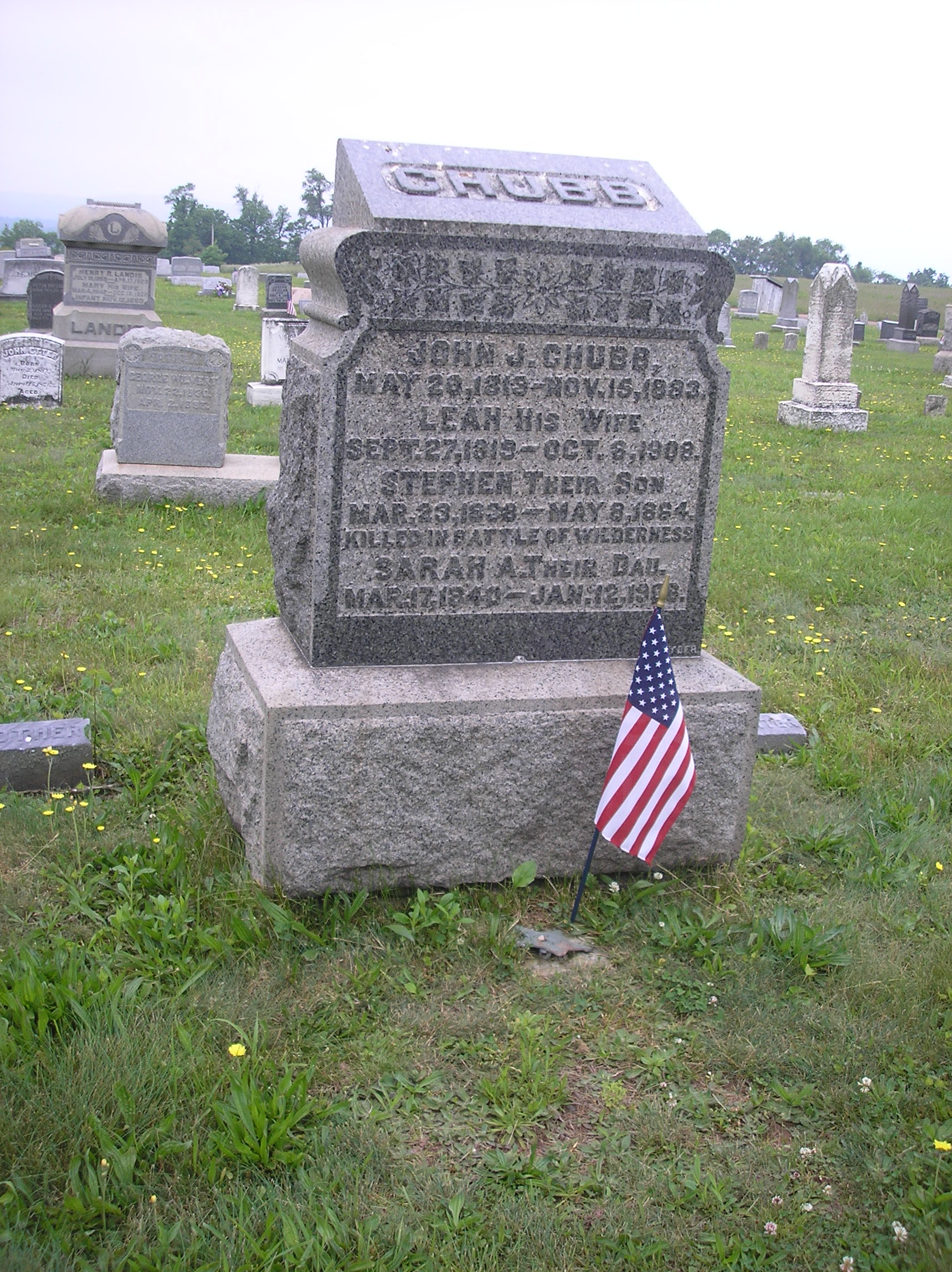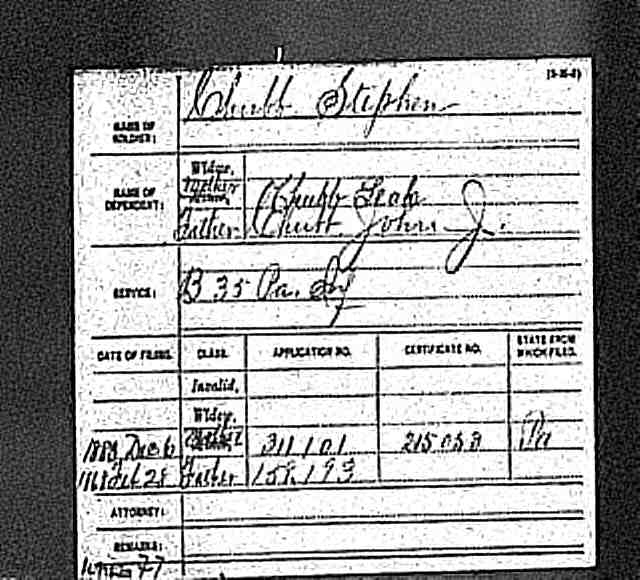Stephen Chubb – Killed at the Wilderness
Posted By Norman Gasbarro on March 8, 2013
On the family grave stone of John Jacob Chubb (1818-1883) in Long’s Cemetery, Halifax, Dauphin County, Pennsylvania, it is noted that Stephen Chubb, the son of John J. Chubb and Leah [Gaymon] Chubb was killed in the Battle of the Wilderness. At the grave site, there is a G.A.R. star, also recognizing his service. At this time it is not known whether Stephen Chubb is buried in Halifax, or whether the stone is only a memorial to him.
According to available records, Stephen Chubb was the oldest child and the only son of John Jacob Chubb, a laborer, and Leah [Gaymon] Chubb. He was born on 23 March 1838, probably in Halifax Township or Matamoras. His younger sisters were: Sarah A. Chubb (born about 184); Ann E. Chubb (also born about 1840, and possibly a twin of Sarah); Agnes Chubb (born about 1843); Mary Chubb (born about 1847); and Louisa Chubb (born about 1849). In 1860, Stephen Chubb is found in the household of George Crawford, a farmer in Dunnstable, Clinton County, Pennsylvania, where he was working as a laborer.
Stephen Chubb was one of the first to answer the call to service in the Civil War, enrolling on 25 May 1861 at Snyder County, but because Pennsylvania had met its quota for 3-month troops, he was placed in “reserve” and not officially mustered into service until 27 July 1861. The regiment to which he was assigned was the 35th Pennsylvania Infantry, which also had the designation of 6th Pennsylvania Reserves. He reported to Washington, D.C., and became a Private in Company B. From the Pennsylvania Veterans’ Index Card (shown above), available at the web site of the Pennsylvania Archives, it is learned that Stephen was 5 foot, 8 inches tall, had brown hair, dark eyes, and a “fresh” complexion. Although he had given his occupation as “laborer” in the 1860 census, he told the military recruiters that he was a farmer.
From the official history of his regiment, the following is learned about his experiences in the war:
The 35th Pennsylvania Infantry, the 6th of the reserves, composed of men from all parts of the state, was ordered with the Kane Rifles to Maryland, then to Greencastle, Pennsylvania, Washington and Tennallytown. It was mustered in at Washington for three years on 27 July 1861 and at Tennallytown was assigned to the 3d Brigade of the Reserve Corps. This brigade won the brilliant victory at Dranesville in December and passed an uneventful winter in camp near Langley. It took part in the strategic movements on the Peninsula in the spring of 1862 and was actively engaged at the Second Bull Run, South Mountain, Antietam and Fredericksburg, where the losses of the 35th were severe. It then went into camp near Belle Plain; took part in the “Mud March;” was ordered to Alexandria in February 1863, and to Fairfax Station in March, where it remained until the Gettysburg Campaign. It was closely engaged in that battle, joined in the pursuit of the enemy and the various marches of the army during the autumn, and went into winter quarters at Kettle Run early in December. In the spring of 1864 it participated in the engagements of the Wilderness Campaign in May and fought its final battle at Bethesda Church After that engagement the regiment started for Harrisburg, where it was mustered out on 11 June 1864, the veterans and recruits being transferred to the 191st Pennsylvania Infantry.
Unfortunately for Stephen Chubb, he did not survive the Battle of the Wilderness; he was killed in action on 8 May 1864, so the history of the regiment which followed that battle does not pertain to him It is not known at this time whether his remains were found and identified at the Wilderness and returned to Halifax for burial, but he is recognized there for his service and sacrifice by his family and for succeeding generations by veterans groups who decorate the graves at Long’s Cemetery in Halifax.
Stephen Chubb, a participant in the Battle of Gettysburg, is also recognized on the Pennsylvania Memorial at Gettysburg, on the plaque for the 35th Pennsylvania Infantry (or the 6th Reserves), as a Private who served in Company B.
After news was received of Stephen’s death, his father John Jacob Chubb applied for pension benefits, but they were not granted to him, perhaps because he was physically able to support himself and his family. But after John Jacob Chubb died in 1883, Stephen’s mother was able to make a successful benefits claim. She lived until 1908 and received government support for about 25 years, such support being based on the fact that her only son was lost in the war. The Pension Index Card, shown above, is from Ancestry.com, and gives the file reference numbers for the pension applications, which are now located at the National Archives in Washington, D.C.
The Civil War Research Project welcomes any additional information about Stephen Chubb that can be supplied by readers of this blog.
 ;
;






Comments